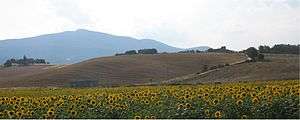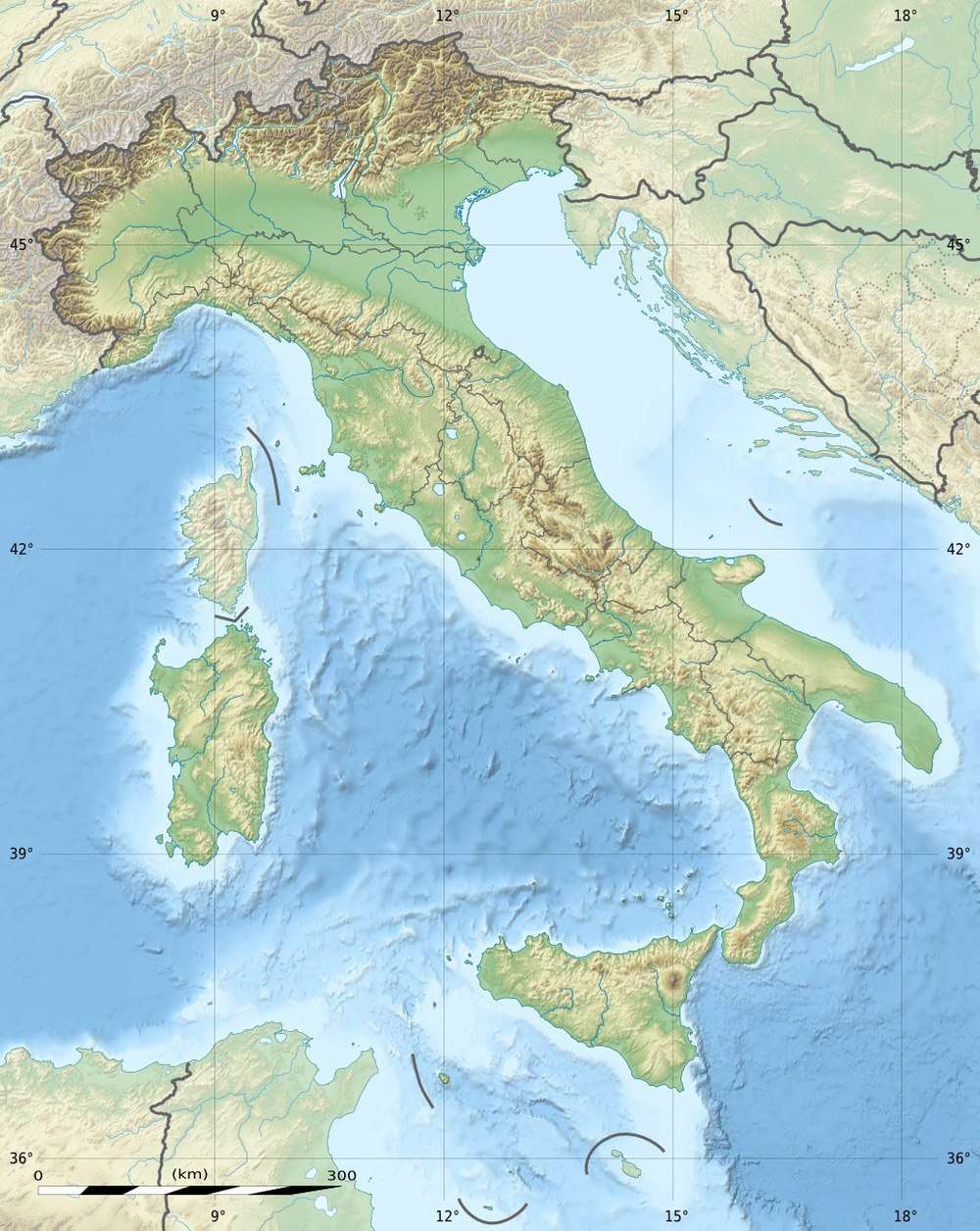Monte Cetona
The Monte Cetona is a mountain located in the southern Tuscany region of Italy.
| Monte Cetona | |
|---|---|
 Overall view | |
| Highest point | |
| Elevation | 1,148 m (3,766 ft) [1] |
| Coordinates | 42°55′48″N 11°52′33″E |
| Geography | |
 Monte Cetona Italy | |
| Location | Tuscany, Italy |
| Parent range | Tuscan Antiapennines |
| Geology | |
| Mountain type | limestone.[2] |
Features

The mountain stands near the SE border of the province of Siena, and closes the long, hilly ridge which divides val d'Orcia from val di Chiana. It belongs to the comuni of Cetona, San Casciano dei Bagni, Radicofani and Sarteano. On its SW slopes is located the spring of the river Orcia, while downstream of the mountain, South of the summit, stands the lago di San Casciano.
Not far from the summit there are several transission masts whose broadcasts, due to prominence and isolation of the mountain, can reach the areas of Perugia, Orvieto and Arezzo. The Monte Cetona belongs to a S.C.I. also named Monte Cetona (code IT5190012), which covers an area of 1604 ha.[3]
Summit cross
On the mountain top stands a high metallic summit cross, built in 1967. It was realised to replace smaller crosses settled there after the II World War. The realization of the project was promoted in 1965 by the parishes of Diocese of Chiusi, after the return of the local bishop from Rome where he took part in the Second Vatican Council. It was officially inaugurated on October the 1st of the same year by Brunetto Bucciarelli-Ducci, former president of the Italian Camera dei Deputati.[4] The lighting system was turned on for the first time June 29 1968 at 9 o'clock in the evening, via radio control, by Pope Paul VI[5]. The cross is 10 metres wide, 15 metres high and its weight is 6.200 tonnes.[4]
Geology

Both the slopes of Monte Cetona facing Val d'Orcia and Val di Chiana are covered by sands and clays up to about 800 metres of elevation. In the uppermost part of the mountain emerges the rocky substrate of a Karstic origin. The summit is partially made of dolomite. North of it some caves can be found. Among them are well known the Grotte del Belvedere (Belvedere caves), openend into the travertine and that were frequented by human beings during the prehistory.[2]
Access to the summit
The summit of Monte Cetona can be reached following several hiking itineraries. Can be mentioned the one starting from Camporsevoli (a small village in the comune of Cetona), which crosses the Valle Saccaia (Sacciaia Valley) and then climbs the Southern ridge up to the summit, and the one starting from Fonte Vetriana, on the W slopes of the mountain.[6]
References
- Guidoni, Enrico; Marino, Angela (1972). Territorio e città della Valdichiana (in Italian). Multigrafica. p. 236. Retrieved 2020-01-06.
- AA.VV. (2005). "Parco archeologico-naturalistico del Monte Cetona". Toscana (in Italian). Milano: Touring Club Italiano. p. 769.
- "SITE IT5190012 SITENAME Monte Cetona". European Environment Agency. Retrieved 2020-01-18.
- Molaioli, Angelo (2006). "La mia croce è più alta della tua". Cetona. Ricordi per il futuro. Testimonianze, foto, cartoline d'epoca per una storia scritta dalla gente (in Italian). Emmecipi. p. 225. Retrieved 2020-01-06.
- AA.VV. (1968). L'Attività della Santa Sede (in Italian). Tipografia poliglotta vaticana. p. 574. Retrieved 2020-01-18.
- "Monte Cetona" (PDF) (in Italian). Club Alpino Italiano - Sezione di Firenze. Retrieved 2020-01-18.
